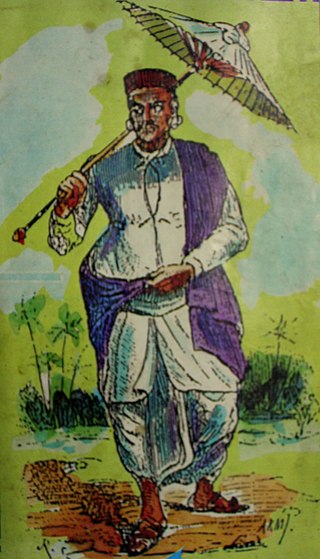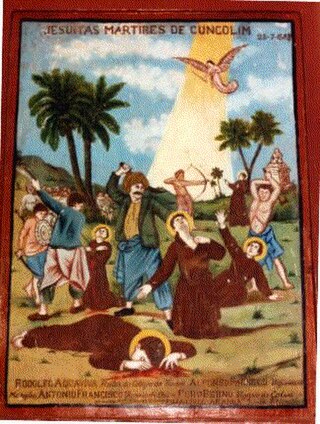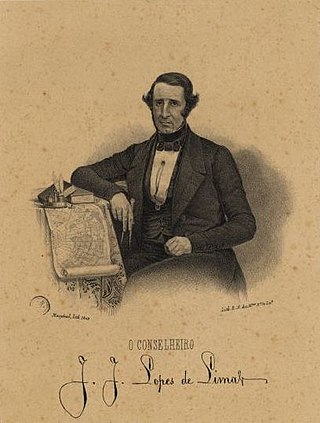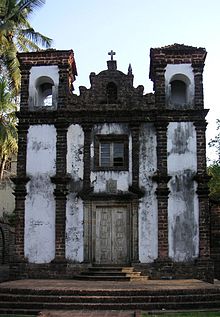
The history of Goa dates back to prehistoric times, though the present-day state of Goa was only established as recently as 1987. In spite of being India's smallest state by area, Goa's history is both long and diverse. It shares a lot of similarities with Indian history, especially with regard to colonial influences and a multi-cultural aesthetic.

The Goa Inquisition was an extension of the Portuguese Inquisition in Portuguese India. Its objective was to enforce Catholic orthodoxy and allegiance to the Holy See. Conversions took place through the Goan Inquisition with the persecution of Hindus and the destruction of Hindu temples.
The Konkani people are an Indo-Aryan ethnolinguistic group native to the Konkan region of the Indian subcontinent who speak various dialects of the Konkani language. Konkani is the state language of Goa and also spoken by populations in Karnataka, Maharashtra, Damaon and Kerala. Other Konkani speakers are found in Gujarat state. A large percentage of Konkani people are bilingual.
Gaud Saraswat Brahmins (GSB), also known as Shenvis are a Hindu community of contested caste status and identity. They primarily speak Konkani and its various dialects as their mother tongue.
Mangalorean Catholics are an ethno-religious community of Latin Christians from the Diocese of Mangalore and the erstwhile South Canara area, by the southwestern coast of present-day Karnataka, India.
The caste system in Goa consists of various Jātis or sub-castes found among Hindus belonging to the four varnas, as well as those outside of them. A variation of the traditional Hindu caste system was also retained by the Goan Catholic community.
Candolim is a census town in North Goa and is located in the Bardez taluka in the state of Goa, India. It is situated just south of Calangute Beach and North of Sinquerim.
Goan Catholics are an ethno-religious community of Indian Christians adhering to the Latin Rite of the Catholic Church from the Goa state, in the southern part of the Konkan region along the west coast of India. They are Konkani people and speak the Konkani language.

Hinduism is the majority religion of people living in Goa. According to the 2011 census, in a population of 1,458,545 people, 66.08% were Hindu.
Goans is the demonym used to describe the people native to Goa, India, who form an ethno-linguistic group resulting from the assimilation of Indo-Aryan, Dravidian, Indo-Portuguese, Austro-Asiatic ethnic and/or linguistic ancestries. They speak different dialects of the Konkani language, collectively known as Goan Konkani. "Goanese", although sometimes used, is an incorrect term for Goans.
The caste system among South Asian Christians often reflects stratification by sect, location, and the caste of their predecessors. There exists evidence to show that Christian individuals have mobility within their respective castes. But, in some cases, social inertia caused by their old traditions and biases against other castes remain, causing caste system to persist among South Asian Christians, to some extent. Christian priests, nuns, Dalits and similar groups are found in India, Pakistan, Bangladesh, and Nepal.

The Daivadnya Brahmin,, is a community from Goa and Karnataka, who claim to have descended from Vishwakarma. Although they claim themselves to be Brahmins and some sources mention them as Brahmin as well, these claims are mostly not accepted by others including local Brahmin castes. They are native to the Konkan and are mainly found in the states of Goa and Damaon, Canara, coastal Maharashtra, and Kerala. Daivadnyas in the state of Maharashtra and Karnataka are classified by National Commission for Backward Classes as an Other Backward Class.
Roman Catholic Brahmin is a caste among the Goan, Bombay East Indian and Mangalorean Catholics who are descendants of Konkani Brahmin converts to the Latin Catholic Church, in parts of the Konkan region that were annexed into the Portuguese East Indies, with the capital (metropole) at Velha Goa, while Bombay was the largest territory (province) of Portuguese India. They retain some of the ethno-social values and customs of their ancestors, and most of them exhibit a noticeable hybrid Latino-Concanic culture. They were known as the Brahmins among the "New Christians".
History of Goan Catholics recounts the history of the Goan Catholic community of the Indian state of Goa from their conversion to Christianity to date.

Roman Catholic Kshatriyas are a modern Christianised caste among Goan, Bombay East Indian, Mangalorean, Kudali & Karwari Catholics. They are patrilineal descendants of Kshatriya and Vaishya Vani converts to the Latin Church, in parts of the Konkan region that were under Portuguese Goan rule. They are known as Chardo in Goan Konkani, Charodi in Canarese Konkani & as Sandori or Vadval in Damanese and Mahraashtrian Konknni, while others also identify as Bhandari or Khatri in their Bombay East Indian dialects.

The Christian population of Goa is almost entirely Goan Catholics, whose ancestors converted to Christianity during the Portuguese rule in India. Christianisation followed the Portuguese conquest of Goa in 1510, which was followed by the Goa Inquisition from 1560 onwards. The Hindu population is mostly descended from immigrants from other states of India, who have been arriving in Goa since the last century There is a higher proportion of Christians in Velhas Conquistas than in Novas Conquistas.
The Konkani language agitations were a series of protests and demonstrations in India, concerning the uncertain future of the Konkani language. They were held by Goans in the former territory of Goa, Daman and Diu; then under the administration of the Maharashtrawadi Gomantak Party (MGP). The protests involved citizen journalism, student activism & political demonstrations. The civil unrest seized when official status for Konkani in the Devnagari script was granted.
Francisco Luís Gomes was a Portuguese physician, writer, historian, economist, political scientist and MP in the Portuguese parliament. A classical liberal by political orientation, Gomes represented Portuguese India in the Cortes Gerais (parliament) from 1861 to 1869. His outstanding contributions towards the fields of classical liberal philosophy and economics led him to be widely hailed as "The Prince of Intellectuals" in Europe.

The Goan Muslims are a minority community who follow Islam in the Indian coastal state of Goa, some are also present in the union territory of Damaon, Diu & Silvassa. They are native to Goa, unlike recent Muslim migrants from mainland India and are commonly referred to as Moir by Goans in Goan Konkani. Moir is derived from the Portuguese word Mouro. The Portuguese called them Mouros because they were in contact with the Moors, people of predominantly Muslim Maghreb country, who had conquered and colonised the Iberian peninsula for centuries.

Xenddi, sometimes spelled as Xendi, was a discriminatory religious tax imposed on non-Christians by the colonial era Portuguese Christian government in Goa, Daman and Diu in 1704 and expanded to all of Portuguese colonies in the Indian subcontinent by 1705. It was similar to the discriminatory Jizya religious tax imposed on Hindus by Muslim rulers in the region.












